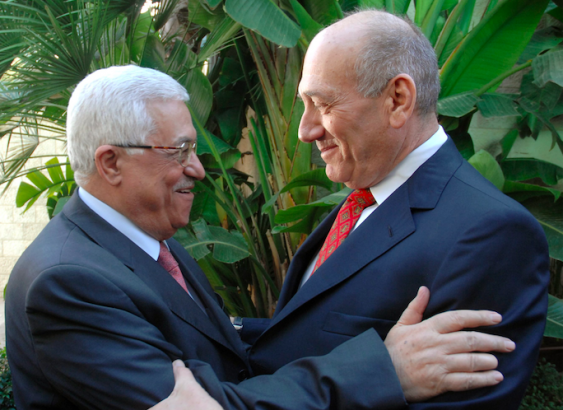The erasure from our historical memory of Israeli attempts to achieve peace by agreeing to Palestinian statehood, and of the serial Palestinian rejections, is now standard practice. This erasure sustains the libel that Israel is an ‘apartheid state’ seeking ‘permanent occupation’ and underpins a ludicrously uncritical attitude to the Palestinian national movement, its leadership, and aspects of its political culture. From Human Rights Watch to Nathan Thrall, Peter Beinart to the Carnegie Endowment, the debate now proceeds as if those offers were never made and never rejected. Bringing those offers back in, and those rejections, we get a more realistic picture of the obstacles standing in the way of achieving two states for two peoples.
‘Who controls the past controls the future: who controls the present controls the past’ is the slogan of the fictional English Socialist Party led by Big Brother in George Orwell’s dystopian novel 1984. Orwell understood that the erasure of history is a useful tool to control the present narrative and to influence the future. While perhaps an exaggerated analogy, there are Orwellian parallels in how anti-Israel organisations and thought leaders now treat some of the key historical elements of the Israel-Palestine conflict.
This is clearly evident in relation to the multiple offers of statehood made by Israel to the Palestinians in the 2000 to 2008 period (the ‘Statehood Offers’). These events do not fit the fictional narrative of those who portray Israel as a colonial-settler enterprise that seeks to dominate the Palestinians in an endless occupation that has been characterised by some as ‘apartheid’.
A central element of this viewpoint asserts that Israel’s control of the West Bank has always been designed to be permanent. (It also considers Gaza to be occupied, despite not a single Israeli being present in the area, but this topic is beyond the scope of this article.) Thus, the notion that the West Bank and Gaza are semi-autonomous entities that may eventually become a sovereign Palestinian state is a fallacy and the whole region between ‘the river and the sea’ must be considered one entity under two systems that by design discriminates against Palestinians.
The concept of ‘permanent occupation’ as Israeli policy is demolished once we undertake a full and honest accounting of the Statehood Offers. Over this period Israel, with the assistance of the Americans who facilitated negotiations in 2000 and 2001, offered the Palestinians a full independent state that according to most Western observers contained all the elements of what a final-status deal should look like. The Clinton Parameters were a set of core positions provided to the Israelis and Palestinians in December 2000 as a vast improvement over the statehood offer in Camp David during the Summer of 2000. The key elements of the parameters were:
- Creation of an independent Palestinian state with contiguity on nearly 100 per cent of the West Bank with land swaps, 100 per cent of Gaza and a dedicated link between the two areas.
- Jerusalem as the capital of Palestine divided under the principle that existing Arab areas would be Palestinian and Jewish ones Israeli. This would also apply to the Old City, which would also be divided.
- Palestinian control of the Temple Mount/Haram and Israeli control of the Western Wall.
- The ‘Right of Return’ for Palestinians would be allowed into the new Palestinian state.
- End of conflict agreement that would end all claims and satisfy all relevant U.N. resolutions.
There is agreement among experts that Ehud Barak accepted the Clinton Parameters while Yasser Arafat said no. Over the years many observers have made endless excuses for Arafat on why his rejection was justified, such as that he was under too much ‘pressure’ or that the negotiations went forward even though Arafat did not want them, but the fact of his rejection is not disputed. Some anti-Israel commentators still peddle falsehoods such as that the offers only provided for non-contiguous ‘Bantustans’ or a capital in Abu-Dis, despite clear evidence to the contrary. In October 2020 Al Arrabiya television released a groundbreaking interview with Prince Bandar of Saudi Arabia who recounted the last hours of Arafat’s rejection of Clinton’s final offer for statehood. Bandar placed all the blame on Arafat and has called the rejection a ‘crime’ and a ‘tragedy.’
On September 16, 2008 Ehud Olmert made a similar offer to Mahmoud Abbas in a presentation made to the Palestinian leader and his negotiating team at Olmert’s Jerusalem residence:
- Creation of an independent Palestinian state with contiguity on nearly 100 per cent of the West Bank with land swaps (6.3 per cent to Israel for the major Israeli settlements exchanged for 5.8 per cent of Israeli territory plus a dedicated link between West Bank and Gaza) and 100 per cent of Gaza.
- Jerusalem as the capital of Palestine with Arab neighbourhoods of East Jerusalem transferred to Palestinian control.
- Placement of the Old City, including the holy sites, under international control by a committee comprised of Saudi Arabia, Jordan, Palestine, Israel and the US, which meant that Israel ceded control of the Temple Mount.
- The ‘Right of Return’ for Palestinians would be allowed into the new Palestinian state with a modest form of symbolic return into Israel proper.
This offer for statehood was rejected by Abbas who skipped a follow up meeting with Olmert the next day, claiming that he ‘had forgotten’ that he had to go to Amman. Abbas did not bother to reschedule or negotiate further and the Olmert statehood offer was officially dead. Years later Olmert said that, ‘From that time, I am still waiting for Abbas’s telephone call.’ American and Palestinian leaders have not disputed these events. Abbas claimed that he said no because he was not allowed to properly study Olmert’s map and chief Palestinian negotiator Saeb Erekat admitted that he was not willing to give up a ‘single inch’ of the June 1967 lines. In 2011 Condoleezza Rice revealed in her memoir that the Americans continued to work with the parties behind the scenes to revive the peace plan. She recounted that President Bush met with Abbas in the Oval Office at the end of 2008 asking him to reconsider Olmert’s offer. Rice concluded that ‘The Palestinian stood firm, and the idea died.’[1]
This erasure of Israeli attempts to achieve peace and grant Palestinians full statehood on nearly 100 per cent of the West Bank and Gaza is now standard practice in the anti-Zionist narrative, which has evolved to libel Israel as an apartheid state. Several documents from the past year clearly demonstrate the practice of erasing any history that contradicts key points in these demonising narratives.
Human Rights Watch
A lengthy April 2021 report by Human Rights Watch (HRW) titled A Threshold Crossed charged Israel with the crime of Apartheid. Central to the claim is the contention that Israel, the West Bank and Gaza are in reality one combined entity with two separate sets of laws, one for Jews and one for Palestinians. By treating the region as one political entity, HRW dismisses the fact that Israel is a democracy with Arabs active in all areas of society, recently highlighted with the entry of an Arab party into the governing coalition. Critical to HRW’s thesis is their assessment that Israel’s control of the West Bank and Gaza has always been intended to be perpetual in nature, indicated on the first page of the report:
Several widely held assumptions, including that the occupation is temporary, that the ‘peace process’ will soon bring an end to Israeli abuses, that Palestinians have meaningful control over their lives in the West Bank and Gaza, and that Israel is an egalitarian democracy inside its borders, have obscured the reality of Israel’s entrenched discriminatory rule over Palestinians … a number of Israeli officials have stated clearly their intent to maintain this control in perpetuity and backed it up through their actions, including continued settlement expansion over the course of the decades-long ‘peace process’.
For the charge of apartheid to ‘stick,’ even within the already heavily manipulated definition of the word, HRW focuses on this concept of permanent control of the territories, there being no intention on Israel’s part to create two independent states. Kenneth Roth, CEO of HRW, recently Tweeted that ‘the no-end-in-sight 30-year “peace process”’ does not absolve Israel of the crime of apartheid, adding that the peace process was a sham meant to mask Israel’s intent of permanent domination. Eric Goldstein, acting executive director of HRW’s Middle East and North Africa division, confirmed that this concept is absolutely central to the apartheid thesis, writing that the peace process obscured the ‘clear intention of Israeli authorities to perpetuate a system of … domination’ and intends to maintain this system.
The reality of the Statehood Offers sharply contradict this key HRW assumption, which is why the report completely avoids a discussion of these events. The only allusion to the Statehood Offers in the report is the following line: ‘The parties did not reach a final status agreement by 2000 and have not in the two decades since, despite off and on negotiations primarily mediated by the US.’ The report further dismisses the negotiations as merely a tactic to ‘oppose efforts for rights-based international action or accountability, and as cover for Israel’s entrenched discriminatory rule over Palestinians in the [Occupied Territories].’ Without any supporting evidence, HRW goes one step further than previous revisionist viewpoints in dismissing Barak and Olmert’s efforts as nothing more than a ruse by Israel to solidify Israeli domination over Palestinians and all the territory.
The egregious disingenuousness of the HRW report is further demonstrated by its cherry-picking of quotes from Israeli officials. The report notes that ‘Statements by Israeli prime ministers and other senior officials highlight the extent to which the intent to maintain demographic control has guided policymaking.’ The report quotes Netanyahu from 2003 and 2019, Ariel Sharon from 2002 and Shimon Peres from 2012. It cites Ehud Olmert, but only from 2003, three years before he became prime minister, with a statement that purports to show his intent to preserve a ‘Jewish majority’. To further prove that Israel has always sought to ensure ‘Jewish control over the land’ and demographic ‘domination’ to ‘confine Palestinians to dense population centres,’ HRW cites snippets from a range of other Israeli figures, both well known and obscure: Ben Gurion from 1948, Jacob Edery, Minister for the Development of the Negev and Galilee, from 2007, a leaked document from Yisrael Koenig, northern district commissioner of the Interior Ministry, from 1976, Ariel Atias, Israel’s Housing Minister, from 2009, Israel Kimhi, director of planning policy at the Interior Ministry, from 1975, Teddy Kolleck, mayor of Jerusalem, from 1982, Labour minister Yigal Allon from 1976 and Member of Knesset Yariv Levin from 2014. But the 200-page report, which HRW and others have touted as comprehensive and well researched, conveniently and incredibly skips over the entire history of the Statehood Offers. HRW’s tactic is to pretend that these events never happened and assume that no one will notice or care.
Nathan Thrall
Another notable example of the erasure of the Statehood Offers is a recent article by frequent New York Times contributor Nathan Thrall titled ‘A Day in the Life of Abed Salama.’ The article has been hailed as an extraordinary piece that breaks new ground, but the 20,000-word document is nothing more than a long-form anti-Zionist essay which for all intents and purposes is the same as the HRW report.
Like the HRW report, Thrall covers a wide swath of history with liberal use of quote snippets ranging from Theodor Herzl in 1895, Yehuda Blum in 1977 and modern leaders, all to show that for more than a century the true goal of Zionism was ethnic cleansing and permanent domination of Arabs by Jews. Also like the HRW report, Thrall omits the Statehood Offers. He mentions Rabin’s plan for a Palestinian entity as ‘less than a state’ and Netanyahu’s ‘state minus’ but conveniently missing are the names Ehud Barak and Ehud Olmert. Thrall’s only reference to the Clinton Parameters is to assert that it allowed Israel to annex certain settlements, again positioning Israel’s actions for peace as sinister. Thrall parrots the proven falsehood that Palestinians were only offered ‘Bantustans,’ a charge which chief US negotiator Dennis Ross called a canard since the well documented plan put forth by President Clinton was for nearly 100 per cent of the West Bank with no possibility for cantons or Bantustans.
Peter Beinart
Peter Beinart, who has recently distinguished himself as perhaps the most prominent anti-Zionist Jew, wrote a notable article in July 2020 calling for a one-state solution. Beinart explains: ‘The painful truth is that the project to which liberal Zionists like myself have devoted ourselves for decades — a state for Palestinians separated from a state for Jews — has failed. The traditional two-state solution no longer offers a compelling alternative to Israel’s current path.’ Beinart further informs the reader that, ‘Understanding why the classic two-state solution is dead requires understanding how its current incarnation was born.’ Astonishingly, his explanation for how the two-state solution evolved and then failed does not include the words Clinton, Arafat or Olmert. A full and honest recounting of the Statehood Offers would totally undermine the fabricated narrative Beinart weaves.
The Carnegie Endowment
In April 2021, the Carnegie Endowment for International Peace issued a report titled Breaking the Israel-Palestine Status Quo. The paper purports to offer an analysis of how to shift US policy after ‘decades of on-and-off negotiations and failed peace initiatives’ but totally fails by not mentioning the names Clinton, Arafat, Barak, and Olmert even once and not assessing the Statehood Offers. The authors’ assert: ‘The growing dominance in Israel of a leadership that openly embraces permanent control of the occupied Palestinian territories and the steady decline of Palestinian democratic governance have been trends for decades.’ Really? Only 13 years ago Olmert offered Abbas a full state that was arguably more generous than that offered under the Clinton Parameters in 2000.
Israel Policy Forum
The downplaying of the Statehood Offers is also a phenomenon of pro-Israel, Zionist organisations such as the Israel Policy Forum. The forum’s core value is to support the ‘realisation of a viable two-state solution’. In February 2021, the organisation published a report titled In Search of a Viable Option, Evaluating Outcomes to the Israeli-Palestinian Conflict but this document also erases the Statehood Offers. It seems that the authors’ desire to appear ‘fair and balanced’ led to the clear avoidance of the elephant in the room: the two-state solution failed in 2000, 2001 and 2008 due to Palestinian rejectionism and refusal to budge from maximalist demands that, if met, would one way or another end Israel as a sovereign Jewish state.
The study’s cover page asks, ‘Is the two-state solution still possible?’ and the first lines of the report note that ‘The two-state solution has been widely criticised from the right and the left as an idea whose time has passed and been overtaken by facts on the ground. As a result, many other models for the Israeli-Palestinian conflict have been advanced.’ Incredibly, in a paper that is specifically devoted to analysing the two-state solution and its alternatives, there is absolutely no analysis of why the two-state solution failed in the 2000 to 2008 period. There is no assessment of the Palestinian negotiating stance at the time, no discussion of why Barak and Olmert said yes while Arafat and Abbas said no, and no review of why these two-state offers were not sufficient for the Palestinians. Clinton is mentioned only twice in the 120-page document and Arafat not at all.
The study concludes that ‘Even though the two-state outcome is the best approach, or the one assessed to be least flawed, it has serious challenges mostly pertaining to acceptance by the current Israeli government, some of whose leaders are working tirelessly to kill it.’ Somehow, to the Israeli Policy Forum none of the fault lies with the Palestinians. The authors’ do not see ‘serious challenges’ related to the Palestinian’s prior rejections of two-state offers and do not even deem it necessary to review the Statehood Offers to draw lessons on why Arafat and Abbas said no.
John Kerry
Secretary of State John Kerry’s speech in December 2016 addressed the Obama administration’s relationship with Israel and the reason behind his decision to abstain from a UN Security Council vote to criticise Israel’s settlements in the West Bank. In a 70-minute speech which recounted many historical aspects of the conflict, Kerry devoted exactly one vague sentence to the Camp David era: ‘President Clinton deserves great credit for laying out extensive parameters designed to bridge gaps in advanced final-status negotiations 16 years ago.’ By ignoring this important milestone in the history of the conflict it allowed Kerry to simply blame the settlements as the key obstacle to peace – not Palestinian rejectionism in any way.
At least President Biden Gets It
It seems that even well-intentioned pro-Israel Zionists who desire to see themselves as ‘honest mediators’ do not want to accept the simplest and depressing answer to why the two-state solution has failed since first proposed in the 1930s: the absolute rejection by most Arabs and Palestinians of Jewish statehood on any borders and its corollary demand of the literal ‘Right of Return’. One only has to listen to President Biden who seemingly ‘gets it’ better than most experts when he recently said: ‘Let’s get something straight here, until the region says unequivocally they acknowledge the right of Israel to exist as an independent Jewish state, there will be no peace.’
References
[1] Condoleeza Rice, No Higher Honor, p. 723-724.






































The weight of evidence of Zionist/Israeli willingness to cede territory for peace is overwhelming. It goes well beyond 2000-8 starting with the Faisal-Weizmann agreement 1919, and the subsequent the partition plans of Peel (1937), UNSCOP (1947), UNSC resolutions 242 (1967) and 338 (1973), the Camp David agreements (1978) and of course Oslo (1993-95). This entire history is regularly ignored by Israel’s “critics.”